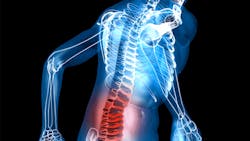As Labor Day approaches, millions of registered nurses (RNs) and other health care workers risk potentially debilitating and career-ending injuries from the manual lifting, transferring and re-positioning of patients, despite availability of technology to protect workers and patients.
Loretta Pierce, emergency department manager at a Veterans Health Administration facility in Omaha, NE, knows from experience. She had back surgery to correct a herniated disc due to the cumulative effects of manual patient handling at previous jobs.
As the former head nurse of a trauma center intensive care unit, she describes a situation where 13 RNs coordinated schedules so they could all be available to lift a morbidly obese patient from a mobile cart to a bed or anytime they moved or re-positioned him to change linens, bathe him or check his backside while keeping his breathing passages clear. Had the hospital had assistive lifting technology, it may have only required two RNs, she says, noting that the average patient weighed about 250 pounds.
Teresa Pasquini, employee health services safe patient handling coordinator at LUHS at Gottlieb Memorial Hospital outside Chicago, says it’s not unusual for patients to weigh 300 pounds or more. LUHS Gottlieb has implemented a program with assistive lifting/moving devices on every unit and a “Backsaver Group” of professionals to educate staff and promote a culture of safety.
“We have a lot of nurses well into their 50s who say they wouldn’t have been able to work this long without the program,” Pasquini says.
An often-cited research statistic concluded that RNs lift 1.8 tons during an average eight-hour shift – the equivalent of a hippo. It may be even more today with the increase in obesity rates.
The U.S. Bureau of Labor Statistics reports that RNs suffer the fifth most musculoskeletal injuries and illnesses involving missed work days, behind such jobs as truckers and laborers. A Public Citizen report notes that health care workers suffer more injuries and illnesses than any other industry and highlights OSHA’s relative lack of health care facility inspections and safety rules.
The American Nurses Association (ANA) wants to curb such preventable injuries through its national safe patient handling and mobility standards. The standards provide a framework for a comprehensive program and for workplace laws, regulations and practices, and align with the Nurse and Health Care Worker Protection Act of 2013 (H.R. 2480), a federal bill intended to reduce injuries.
About the Author

Sandy Smith
Sandy Smith is the former content director of EHS Today, and is currently the EHSQ content & community lead at Intelex Technologies Inc. She has written about occupational safety and health and environmental issues since 1990.
